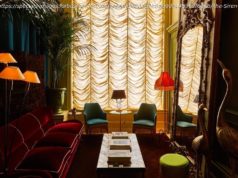 PARIS — At the end of the Jean Paul Gaultier couture show — after a stream of etched tuxedo suits, 1980s Crayola leathers and mega-shoulder furs with hibiscus prints; after the models had finally left the runway and the audience started packing up — a man with a guitar slung around his neck appeared and perched on a stool by the side of the stage. Oops. Guess it wasn’t over after all.
PARIS — At the end of the Jean Paul Gaultier couture show — after a stream of etched tuxedo suits, 1980s Crayola leathers and mega-shoulder furs with hibiscus prints; after the models had finally left the runway and the audience started packing up — a man with a guitar slung around his neck appeared and perched on a stool by the side of the stage. Oops. Guess it wasn’t over after all.
Then up the curtain went again, to reveal … a barefoot girl standing on a swing in an angelic silken nightie with a long blond braid trailing down her back and lacy sleeves like wings.
She swayed to and fro for awhile to the strumming, then hopped off the swing and twirled down the catwalk before being swept off her feet by a shirtless stud in denim overalls, deposited in a wheelbarrow and carted off with great fanfare, into the sunset. Or at least backstage.
It was a vignette sweetly meant. But couture bills itself as “the dream.” And are women’s dreams these days really about being spirited into the future by a hunk-a-hunk of burning man flesh?
That was mostly a rhetorical question.
There’s a reason that Isabelle Huppert, just off her best actress Oscar nomination for playing a woman in “Elle” who, instead of falling to pieces after an attack, takes her vengeance into her own hands, attended the Armani Privé show not in the usual elaborate cocktail gown that celebrities favor for the front row, but rather a turquoise trouser suit and black mock turtleneck, and looked the cooler for it.
When her fellow front-row celeb, Nicole Kidman , in a classic little black dress with statement jewels, knelt down to pay homage, you thought, “I know what you mean.”
It was, on the other hand, more difficult to figure out what Mr. Armani meant with the tangerine dream on the runway, from orange croc jackets to orange sequined slithers to long jeweled orange vests (there was some black, too).
To paraphrase Prime Minister Justin Trudeau of Canada , it’s 2017.
The issue of how relevant a historic discipline that is defined by making handmade clothes to order for the very few can be in a world roiled by social and political disruption was unavoidable this week — in part because the couture shows began just after the Woman’s March on Washington, not to mention its sister marches all over the world , including Paris, and ended just before the March for Life. It seemed, at least to start, an unfortunate juxtaposition. It was hard not to think we were in the middle of a Marie Antoinette moment in the making.
Especially when Giambattista Valli situated his show of high/low ball gowns, minidresses cut to the thigh in front and streaming trains of mousseline and silk faille behind, in the Archives Nationales. The historic venue, that is to say, where the young queen’s papers are kept (including the final letter she wrote before her beheading). The idea did not go over well with a French national trade union, which handed out leaflets in protest of the desecration-by-frivolity.
Still, after it was all over, after we had finished the trek from one cultural monument to the other — from the Musée Rodin, Invalides, the Centre Pompidou, the Palais de Chaillot, the Cirque D’Hiver (in case, you know, anyone was in any doubt about whether the French consider this particular discipline part of their patrimony) — it was clear that behind the tulle and chiffon, the crystals and crepe, efforts were being made to bridge the gap between escapism and the contemporary.
Couture is often treated as synonymous with the most extreme form of self-indulgence, in part because of designers’ own tendency to self-indulge with the decoration (more sequins! more encrustation!) and the show décor. But at its essence it is, or is when it succeeds, about empowering the individual.
A point made crystal clear by John Galliano in a perfectly judged Maison Margiela show that was a graceful meditation on the connection between foundation and presentation. Silk trench coats were sliced away and reduced to checkerboards to give glimpses of the garments beneath; a tweed blouse over a bias satin skirt unspooled on one side. Faces, from the filters we use to transform ourselves on social media, were traced on sheer overcoats or cut into cascading gowns, or imprinted on tulle. In those eyes, you saw yourself.
Elsewhere, the difference was in the details.
At Christian Dior , the first woman to run the house, Maria Grazia Chiuri, performed a deceptive sleight of hand. In a tent in the gardens of the Musée Rodin, she constructed a verdant moss-covered maze around a magical tree dripping jewels and trinkets that recalled nothing so much as “A Midsummer Night’s Dream.” She populated it with Little Black Riding Hood tailleurs and an array of evermore romantic evening dresses clasped at the waist by sculptural belts and crowned at the head.
Yet, fancy though they were, the clothes had a shrugged-on insouciance. Oh, this old ball gown? Paired with barely there kitten heels that kicked up the moss as the models strode along, they looked as comfortable as a sweatshirt. Ms. Chiuri said she had been fascinated by the concept of transformation (hence the masked ball theme, and the set), but the real transformation was in taking a formal garment and giving it a palpable ease, so the woman inside could just, well — get on with it.
Likewise, at Valentino , Pierpaolo Piccioli accessorized his Grecian columns and palazzo pants and Aphrodite dresses with flat leather-strap sandals, the kind found at many an Italian resort, and loosed — or lost — the structure from his clothes. Instead of being armored, or preserved in amber, femininity was being unbound, shrouded in crepe pleats and veils of tulle.
(Mr. Piccioli and Ms. Chiuri worked together as design partners for more than two decades, and this season marked each of their solo couture debuts, so, if they were thinking along the same lines, it’s understandable. The separation process is probably going to take a while.)
The idea that flat shoes could represent progress may seem absurd. But this is a world where words like “fairy and “princess” are used so often they have become clichés. In that context, a sandal and absolute simplicity can be a radical move. So was swapping out the paillettes and bugle beads, the way Riccardo Tisci did at Givenchy, and instead using small circular fabric “mirrors” as adornment on cold-shoulder prairie-queen silk gowns. The most complicated dress in the collection, one that took 2,000 hours to make, was composed solely of linked dream catchers, each woven from black thread by hand in a different pattern.






